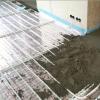- The surface of the wall is cleaned of dust, then slightly moistened.
- The solution is taken on a trowel (trowel), then thrown onto the prepared surface. The resulting layer is uneven, and this is exactly what is needed for better adhesion between layers.
- The second layer is thicker. It is applied with a trowel over the entire surface of the channel, from the very beginning to the end.
Sheathing with asbestos-cement sheets
This method allows you to save twice as much heat. Its essence is in the decoration of the brick walls of the channel with asbestos-cement slabs. Sticking is performed on a plastering solution, which is prepared according to the above technology.
- After reinforcing the surface with a metal mesh, the first layer of plaster is applied by spraying.
- A second layer is applied to the dried first layer and asbestos-cement sheets cut to the appropriate sizes are glued onto it.
On a note
Given the lack of environmental friendliness of asbestos, this method of chimney thermal insulation is more suitable for cold attics. It allows you to partially balance the thermal regime inside and outside the pipe, which significantly reduces the formation of condensate, as well as improves fire protection.
Sheet iron can be used to finish brick structures. Such sheathing is performed on a layer of insulation.
Creating an insulating casing
A single metal pipe not protected by insulation is the most dangerous option in terms of fire. In addition, it does not retain heat well, given the high thermal conductivity of the metal. Between it and structures made of wood and plastic, you need to keep a distance of at least 60 cm. But even then you can get burned if you accidentally touch it. Therefore, the issue of isolation still remains relevant.
The simplest method of isolation in such a case is the creation of a multilayer sandwich structure.
- The overlapping chimney is wrapped with mats of basalt non-combustible wool, which are thinner than 50 mm. The melting point of this insulation is close to 1000˚, which is much higher than the temperature of the smoke.
- A knitting steel wire is laid over the thermal insulation and fixed.

- Then plaster is applied according to the technology described above, using a cement-lime or clay-sand mortar.
- Instead of plaster, you can use a casing made of sheet iron. The sheet must have a width of at least 1 m. The metal blank is rolled up along the diameter of the pipe with a layer of insulation and riveted along the joining line of the edges. The corners are rounded by hand or rolled rollers are used for this.
On a note
The isolation process is continued by repeating the procedure as many times as required. In this case, the next sheet is laid with an overlap, securing its lower edge.
Chimney insulation in the ceiling
![]()
The sections of smoke channels at the place of passage through the ceiling are perhaps the most critical, and therefore require special attention. This event is mandatory when installing any type of chimney. It involves the device box.
When performing passes, the following conditions are observed:
- The edges of the holes made on the roof and in the ceiling must be at least 0.25–0.35 m further than the edges of the chimneys.
- This space is tightly filled with non-combustible heat-insulating material. As a rule, it is stone or basalt wool.
- Wooden structures located near the aisles are treated with flame retardants.
Even if insulated, the chimney also needs proper maintenance. In particular, it must be cleaned of soot at least three times during the year, the furnace furnace must be freed from ash in a timely manner, and materials intended exclusively for these purposes should be used for the furnace.

